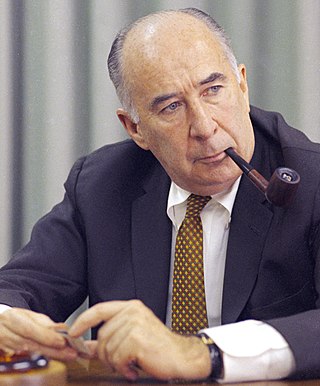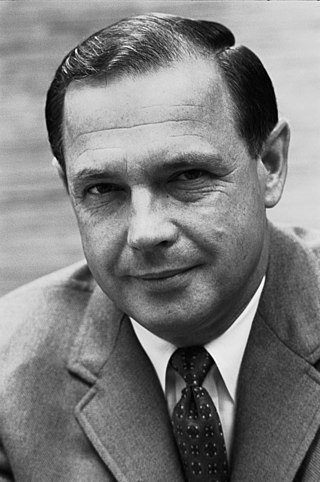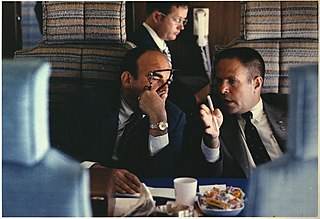
Richard Milhous Nixon was the 37th president of the United States, serving from 1969 until his resignation in 1974. A member of the Republican Party, he previously served as a representative and senator from California and as the 36th vice president from 1953 to 1961 under President Dwight D. Eisenhower. His presidency saw the reduction of U.S. involvement in the Vietnam War, détente with the Soviet Union and China, the Apollo 11 Moon landing, and the establishment of the Environmental Protection Agency and Occupational Safety and Health Administration. Nixon's second term ended early when he became the only U.S. president to resign from office, as a result of the Watergate scandal.

The Watergate scandal was a major political scandal in the United States involving the administration of President Richard Nixon which began in 1972 and ultimately led to Nixon's resignation in 1974. It revolved around members of a group associated with Nixon's 1972 re-election campaign breaking into and planting listening devices in the Democratic National Committee headquarters at the Watergate Office Building in Washington, D.C., on June 17, 1972, and Nixon's later attempts to hide his administration's involvement.

John Newton Mitchell was the 67th Attorney General of the United States, serving under President Richard Nixon and was chairman of Nixon's 1968 and 1972 presidential campaigns. Prior to that, he had been a municipal bond lawyer and one of Nixon's associates. He was tried and convicted as a result of his involvement in the Watergate scandal.
The silent majority is an unspecified large group of people in a country or group who do not express their opinions publicly. The term was popularized by U.S. President Richard Nixon in a televised address on November 3, 1969, in which he said, "And so tonight—to you, the great silent majority of my fellow Americans—I ask for your support." In this usage it referred to those Americans who did not join in the large demonstrations against the Vietnam War at the time, who did not join in the counterculture, and who did not participate in public discourse. Nixon, along with many others, saw this group of Middle Americans as being overshadowed in the media by the more vocal minority.

Harry Robbins "Bob" Haldeman was an American political aide and businessman, best known for his service as White House Chief of Staff to President Richard Nixon and his consequent involvement in the Watergate scandal.

John Daniel Ehrlichman was an American political aide who served as White House Counsel and Assistant to the President for Domestic Affairs under President Richard Nixon. Ehrlichman was an important influence on Nixon's domestic policy, coaching him on issues and enlisting his support for environmental initiatives.

Thelma Catherine "Pat" Nixon was First Lady of the United States from 1969 to 1974 as the wife of President Richard Nixon. She also served as the second lady of the United States from 1953 to 1961 when her husband was vice president.

Alexander Porter Butterfield is a retired United States Air Force officer, public official, and businessman. He served as the deputy assistant to President Richard Nixon from 1969 to 1973. He revealed the White House taping system's existence on July 13, 1973, during the Watergate investigation but had no other involvement in the scandal. From 1973 to 1975, he served as administrator of the Federal Aviation Administration.

Peter Joseph Brennan was an American labor activist and politician who served as United States Secretary of Labor from February 2, 1973, until March 15, 1975, in the administrations of Presidents Nixon and Ford. Brennan had previously been the president of both the Building and Construction Trades Council of Greater New York and the Building and Construction Trades Council of New York, and he returned to the former position after leaving the Ford administration. He was a strong opponent of affirmative action measures to increase the number of minority construction workers. After organizing a demonstration in support of the Nixon administration that turned into the Hard Hat Riot of May 8, 1970, where construction workers violently attacked student anti-war protesters, Brennan was wooed by the Nixon administration as a potential supporter in the 1972 presidential election. His work for Nixon in that election was crucial in increasing the vote for Nixon in New York and in the union movement.

The Moratorium to End the War in Vietnam was a massive demonstration and teach-in across the United States against the United States involvement in the Vietnam War. It took place on October 15, 1969, followed a month later, on November 15, 1969, by a large Moratorium March in Washington, D.C.

From February 21 to 28, 1972, United States President Richard Nixon visited the People's Republic of China (PRC) in the culmination of his administration's efforts to establish relations with the PRC after years of U.S. diplomatic policy that favored the Republic of China in Taiwan. His visit was the first time a U.S. president had visited the PRC, and his arrival in Beijing ended 25 years of no communication or diplomatic ties between the two countries. Nixon visited the PRC to gain more leverage over relations with the Soviet Union, following the Sino-Soviet split. The normalization of ties culminated in 1979, when the U.S. transferred diplomatic recognition from Taipei to Beijing and established full relations with the PRC.

Anna Chennault, born Chan Sheng Mai, 陳香梅, also known as Anna Chan Chennault or Anna Chen Chennault, was a war correspondent and prominent Republican member of the U.S. China Lobby. She was married to American World War II aviator General Claire Chennault.

Richard Gregory Tuck was an American political consultant, campaign strategist, advance man, and political prankster.

Hannah Elizabeth Milhous Nixon was the mother of U.S. president Richard Nixon. Hannah's influence on her son was profound, and he frequently spoke about his admiration for his mother, including at his farewell speech to the White House staff.

Richard Nixon's tenure as the 37th president of the United States began with his first inauguration on January 20, 1969, and ended when he resigned on August 9, 1974, in the face of almost certain impeachment and removal from office, the only U.S. president ever to do so. He was succeeded by Gerald Ford, whom he had appointed vice president after Spiro Agnew became embroiled in a separate corruption scandal and was forced to resign. Nixon, a prominent member of the Republican Party from California who previously served as vice president for two terms under president Dwight D. Eisenhower from 1953 to 1961, took office following his narrow victory over Democratic incumbent vice president Hubert Humphrey and American Independent Party nominee George Wallace in the 1968 presidential election. Four years later, in the 1972 presidential election, he defeated Democratic nominee George McGovern, to win re-election in a landslide. Although he had built his reputation as a very active Republican campaigner, Nixon downplayed partisanship in his 1972 landslide re-election.

Operation Sandwedge was a proposed clandestine intelligence-gathering operation against the political enemies of U.S. President Richard Nixon's administration. The proposals were put together by Nixon's Chief of Staff H. R. Haldeman, domestic affairs assistant John Ehrlichman and staffer Jack Caulfield in 1971. Caulfield, a former police officer, created a plan to target the Democratic Party and the anti-Vietnam War movement, inspired by what he believed to be the Democratic Party's employment of a private investigation firm.

"Bring Us Together" was a political slogan popularized after the election of Republican candidate Richard Nixon as President of the United States in the 1968 election. The text was derived from a sign which 13-year-old Vicki Lynne Cole stated that she had carried at Nixon's rally in her hometown of Deshler, Ohio, during the campaign.

The pardon of Richard Nixon was a presidential proclamation issued by President of the United States Gerald Ford on September 8, 1974, granting a full and unconditional pardon to Richard Nixon, his predecessor, for any crimes that he might have committed against the United States as president. In particular, the pardon covered Nixon's actions during the Watergate scandal. In a televised broadcast to the nation, Ford, who had succeeded to the presidency upon Nixon's resignation, explained that he felt the pardon was in the best interests of the country and that the Nixon family's situation was "a tragedy in which we all have played a part. It could go on and on and on, or someone must write the end to it. I have concluded that only I can do that, and if I can, I must."

Manuel "Manolo" Sanchez was a long-time valet to Richard Nixon, known for his unfailing loyalty and fierce devotion to the former United States president. Sanchez was born in Spain and immigrated to Cuba at a young age. There, he worked as a dishwasher and laborer before moving to the United States. He was employed by Richard Nixon from 1962 to about 1980. The famously reserved Nixon developed a close friendship with Sanchez and once described him as a member of his family.

The presidential transition of Richard Nixon began when he won the 1968 United States presidential election, becoming the president-elect, and ended when Nixon was inaugurated on January 20, 1969. Nixon had become president-elect once the election results became clear on November 6, 1968, the day after the election. This was the first presidential transition to take place following the passage of the Presidential Transition Act of 1963.





















